|
Carbo vegetabilis 30C: Bambus, outdoors, south-facing garden, biodynamic approach. Bambus had brown leaves after flowering – it had collapsed (late summer 2008); was watered for 3 weeks almost daily with a solution of Carbo veg. in water; sprouted normally again in 2009.
Flowering cherry, outdoors, suddenly stopped growing – no leaves, early loss of leaves in spring 2010 and early summer 2010, heat wave, but sufficient watering. Recovered after the same treatment in July.
I've now been experimenting with a potted rose that threatened to die (summer). No obvious reason, but the leaves became yellow and dropped off, and the buds dried up. Twice I put down a pellet of Carbo vegetabilis and Arsenicum, both 30C, on the ground and watered over it. The leaves stopped falling and then new leaves appeared, and now there are even new buds! The effect of the homeopathic remedies strikes me as a miracle!
Carbo vegetabilis – Orchid successfully revived
A
wilting orchid, which had been thrown onto the compost heap because it
no longer produced any flowers, was repotted by Ms J. and given
homeopathic treatment. At short intervals she gave it doses of Arnica 200 C, Aconitum 200 C, and then Carbo vegetabilis 30 C
(3 pellets in 50 ml water). Ms J. always gives the first two remedies
when repotting or changing the position of a plant: effects of injury (Arnica), shock (Aconitum) from repotting. Carbo vegetabilis 30 C
was given last to generally strengthen the plant. This took place in
mid-June. By the end of August the orchid had noticeably recovered and
had started producing the first flowers.
Welden, Germany, 2012

 » Carbo vegetabilis order » Carbo vegetabilis order
Carbo vegetabilis C 30 - Fruit End Rot in Tomatoes
For my tomatoes affected by fruit end rot, I ordered Carbo vegetabilis 30 C. This is what I found:
Fantastic!!! For eight years I have been lovingly growing tomato plants (old varieties), which grow superbly in expensive tomato compost and form fruits but then began to rot, until I'm forced to throw them in the bin, swearing never to grow tomatoes again. This year too the plants grew strongly and produced fruit, and the first three plants already had rotten tomatoes ... After a girlfriend recommended your products, I immediately ordered the remedy. It arrived but I could only add two (instead of the recommended five) doses to the water because I was then away for ten days. I imagined that I would have to throw the tomatoes in the bin on my return... but nothing of the sort! I arrived home to find not a single brown tomato! I'm really excited. Finally I can enjoy healthy tomatoes – kilos of them.
Many thanks for this great product!
Meta Dantl, Passau, Germany 2014

Carbo vegetabilis: Tomato blight treated with Carbo vegetabilis C 30
Mrs. Suter writes about the homeopathic treatment in her garden:
Simply FANTASTIC, works really well, I'm totally enthusiastic and sometimes speechless too ...
What fascinated me most was the treatment of a tomato plant that was almost about to die. Tomato blight had spread widely in the lower part of the plant, and the little leaves at the top already had small brown spots. At this point the tomatoes had not yet set fruit. I watered the tomatoes, which were growing in a plastic housing with one side open, on four consecutive days with Carbo veg. 30 C, (5 pellets in 1 litre of water, dissolved in a watering can).
The plant then developed numerous fresh green leaves, and the leaves affected by blight fell off. It recovered completely, even becoming the best tomato plant in our garden. This experience was a “revelation” for me and it also convinced my husband to continue with homeopathy.
Another tomato plant had something like water-filled brown spots on the underside of the fruits, and these spread from below to cover the tomatoes as they matured (picture 1). This plant was treated starting on August 4, 2013 for four consecutive days with Carbo veg. 30 C. For a long time it looked as if there was no improvement. But now, three weeks after applying the remedy, it has become clear that – although a few tomatoes still have brown spots below – they appear to have dried up and are no longer spreading to cover the entire tomato (picture 2). The younger tomatoes are completely healthy (picture 3)!
Mrs. Suter, St.Marien, Switzerland 2013
 » Carbo vegetabilis order » Carbo vegetabilis order
Carbo vegetabilis: young pear tree: treatment of pear trellis rust
A young pear tree was affected by pear trellis rust in the first year after planting. This fungus affects the branches of various species of juniper, with the spores being transmitted on the wind to the leaves of pear trees. Ms B.'s neighbour had such a juniper in her garden. Initially the leaves showed light orange-red spots at the tips of the leaves, which then gradually enlarged, spreading over the leaves of the tree. Later long growths could be seen on the undersides of the leaves. The rust attacks recurred in the following years. The tree had scarcely any leaves, the fruit did not grow well, falling off early, and Ms B. was about to give up and cut the tree down.
In the spring of 2012 she watered her pear tree following the recommendations of Christiane Maute (Homeopathy for Plants) twice with 8 pellets of Carbo vegetabilis 30 C in 30 litres of water, at an interval of one week. After a short time, the rust on the leaves diminished. The leaves gradually became greener and thicker. The tree seemed to be recovering. A few pears fell off again but in autumn she was able to harvest a good number of pears and she was pleased by how the tree was looking.

Carbo vegetabilis – aphids, whitefly and tomato blight
The tomato plants were watered straight after planting and 6 weeks later with Carbo vegetabilis 30 C (5 pellets in 5 litres of water), as recommended by Christiane Maute. So far there has been no sign of tomato blight, despite the dense planting in a greenhouse. The tomatoes are firmer than ever and have so many fruit that they even need to be supported.
Dominik Albert, Buchen, Germany 2014
 » Carbo vegetabilis order » Carbo vegetabilis order
|